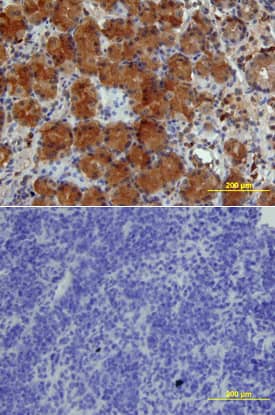Human IGFBP-4 Biotinylated Antibody Summary
Asp22-Glu258
Accession # AAA62670
Applications
Human IGFBP-4 Sandwich Immunoassay
Please Note: Optimal dilutions should be determined by each laboratory for each application. General Protocols are available in the Technical Information section on our website.
Scientific Data
 View Larger
View Larger
IGFBP‑4 in Human Stomach. IGFBP-4 was detected in immersion fixed paraffin-embedded sections of human stomach array using Goat Anti-Human IGFBP-4 Biotinylated Antigen Affinity-purified Polyclonal Antibody (Catalog # BAF804) at 10 µg/mL overnight at 4 °C. Tissue was stained using the Anti-Goat HRP-DAB Cell & Tissue Staining Kit (brown; Catalog # CTS008) and counterstained with hematoxylin (blue). Lower panel shows a lack of labeling if primary antibodies are omitted and tissue is stained only with secondary antibody followed by incubation with detection reagents. View our protocol for Chromogenic IHC Staining of Paraffin-embedded Tissue Sections.
Reconstitution Calculator
Preparation and Storage
- 12 months from date of receipt, -20 to -70 °C as supplied.
- 1 month, 2 to 8 °C under sterile conditions after reconstitution.
- 6 months, -20 to -70 °C under sterile conditions after reconstitution.
Background: IGFBP-4
Human IGF binding protein 4 (IGFBP-4) was isolated from human plasma based on its ability to bind immobilized IGF-I. Human IGFBP-4 cDNA encodes a 258 amino acid (aa) residue precursor protein with a predicted 21 aa residue signal peptide that is processed to generate the 237 aa residue mature human IGFBP-4. The human IGFBP-4 contains a potential N-linked glycosylation site and shares approximately 90% amino acid sequence identity with both the mouse and rat IGFBP-4.
According to the nomenclature of IGFBPs defined at the 4th International Symposium of IGFs (1997, Tokyo), six high-affinity IGF binding proteins (IGFBP-1, -2, -3, -4, -5, -6), and four IGFBP-related proteins (IGFBPr-1, - 2, -3, -4) have been identified. All IGFBPs have a high cysteine content and share conserved cysteine residues that are clustered in the amino- and carboxy-terminal third of the molecule. IGFBPs have been shown to either inhibit or enhance the biological activities of IGF, or act in an IGF-independent manner. Post-translational modification of IGFBPs, including phosphorylation and proteolysis, have been shown to modify the affinities of the binding proteins for IGF and may indirectly regulate IGF actions.
- Jones, J. I. and D.R. Clemons (1995) Endocrine Rev. 16:3.
- Kelly, K.M. et al. (1996) Intl. J. Biochem. Cell Biol. 28:619.
- Kim, H-S. et al. (1997) Proc. Natl. Acad. Sci. USA 94:12981.
Product Datasheets
Citation for Human IGFBP-4 Biotinylated Antibody
R&D Systems personnel manually curate a database that contains references using R&D Systems products. The data collected includes not only links to publications in PubMed, but also provides information about sample types, species, and experimental conditions.
1 Citation: Showing 1 - 1
-
Steroids and protein markers in the follicular fluid as indicators of oocyte quality in patients with and without endometriosis.
Authors: Wunder DM, Mueller MD, Birkhauser MH, Bersinger NA
J. Assist. Reprod. Genet., 2005-06-01;22(6):257-64.
Species: Human
Sample Types: Follicular Fluid
Applications: ELISA Development
FAQs
No product specific FAQs exist for this product, however you may
View all Antibody FAQsReviews for Human IGFBP-4 Biotinylated Antibody
There are currently no reviews for this product. Be the first to review Human IGFBP-4 Biotinylated Antibody and earn rewards!
Have you used Human IGFBP-4 Biotinylated Antibody?
Submit a review and receive an Amazon gift card.
$25/€18/£15/$25CAN/¥75 Yuan/¥2500 Yen for a review with an image
$10/€7/£6/$10 CAD/¥70 Yuan/¥1110 Yen for a review without an image
